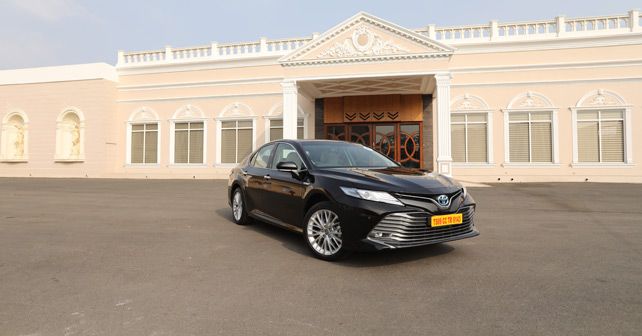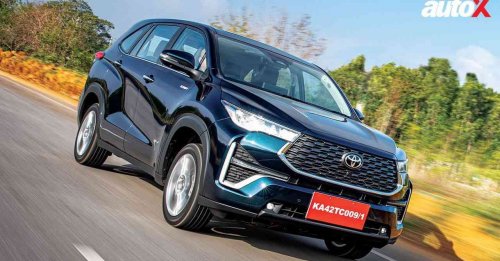
‘Hybrid’ may not quite be the buzzword that EV has become, but the fact is that hybrids can be both efficient and cost effective. Here’s Toyota’s new Camry – this time only in hybrid spec – which demonstrates that hybrids could well be the present-day solution that we’ve been looking for.
Electric cars are dominating headlines in the automotive world today. So you can’t blame people for thinking that electric vehicles are the answer to all the difficult questions regarding environment and ecology facing the automobile industry today. Questionable media reporting, especially the inability to distinguish between facts and fantasy by the so-called new-age media, certainly helps fuel such perceptions. And there’s no doubt that the idea of autonomous vehicles makes for a very good story – one that sells like a dream in fact – but haven’t we all been reading about flying cars for a few decades now? The claim that EVs are greener than cars powered by other energy sources, to put it simply, is a gross oversimplification. The situation is a lot more complicated than some would have you believe. But that’s an argument for another day, and one that almost impossible to make in just a couple of pages.
Now, let’s get a few things straight. Air pollution and environmental damage are real problems of today’s world – problems that we can no longer ignore. It’s also a fact that transportation, in all its forms, is a major contributor to this problem. Automobile manufactures have different ideas on how to tackle the problem. Toyota doesn’t think that the pure electric vehicle is the answer for a multitude of reasons. The prohibitive cost of producing electric cars – both in terms of the ecological cost of producing batteries and the cost difference between the production of an ICE-powered vehicle and an electric car – is chief among them. Now, in a country like India, where per capita income levels are still low and private vehicle owners are still highly price sensitive, the problem of cost assumes a dimension that a vehicle manufacturer simply can’t ignore.
The best way forward then is to look for some middle ground – one that exploits the outer limits of fuel efficiency and limits pollution, while keeping the prices of vehicles relatively affordable. The quintessence of this technology in Toyota’s India range is the new Camry Hybrid. Based on the latest Toyota New Generation Architecture (TNGA) platform, this fourth-generation Hybrid vehicle benefits from Toyota’s years of research and experience in hybrid technology.
Curves where you least expect them
You can’t help but be pleasantly surprised when you take a look at the new Camry. It’s beautifully designed and has a distinctive charm that stands out in a crowd. Sure, the huge plastic grille up front is a bit much, but the car overall is strikingly arresting – especially in profile. A strong shoulder line runs along the sides, adding to the overall character of the design. The deep indent on the rear quarter panel is a particularly impressive piece of engineering. The best view of the car, however, has to be from the rear. The large, swooping taillights and boot lid give it a dash of Italian flair and makes it look very attractive. The large 18-inch wheels fill up the wheel arches nicely and are well-proportioned, endowing the car with a very balanced look.
The interior too has been designed very well. The uncluttered layout, with ergonomically placed controls, makes the cockpit elegant and practical. At the centre lies a responsive 8-inch touchscreen multimedia system, which allows you to control both the audio and the navigation system. And while the touchscreen functions quite well, Toyota has been slow in adapting to changing technology in this realm. I’m talking about the absence of Apple CarPlay or Android Auto in the Camry – or in any other Toyota product in India, for that matter – which is disappointing and something that really needs to be remedied in today’s connected world. A nice surprise is the standard-fit HUD display, which projects vital information on the front windscreen in front of the driver and works very well.
Fit for a King
Now, owners of a product like the Camry in India usually prefer to be chauffeured around, and in that respect, the Camry is simply excellent. There is more than ample space – head, leg and shoulder room – to fit five adults with ease. The seats are incredibly comfortable, and the front seats are ventilated – a fantastic and practical function, given our typical climate.
Another highlight of the new Camry is its extremely quiet cabin. While developing the new architecture, Toyota’s engineers worked extensively towards making the cabin a very quiet place to spend time in – this is also evident in the new Lexus ES, with which the Camry shares its platform. In simple terms, the isolation from the outside environment and the NVH (noise, vibration and harshness) levels of the car are class-leading.
At the rear, the new Camry features a double-wishbone suspension, while at the front it has traditional McPherson struts – all of which gives it absolutely fantastic ride quality. In terms of equipment, the Camry doesn’t leave you wanting for anything either – for the standard equipment list is very comprehensive and features nine airbags, the usual bevy of active and passive safety systems, a nine-speaker JBL audio system, LED headlights and an adjustable rear seat that you can recline for additional comfort. And, for the benefit of rear-seat passengers, the central armrest in the back features controls for the air conditioning and even the rear power sunshade.
Not exactly a driver’s car
Now, let’s be honest, the new Camry is not a driver’s car – but it not posing as one. The 2.5-litre Atkinson cycle engine is paired to a single electric motor, and the battery for the Hybrid system is mounted below the rear seat. And while the car has a CVT transmission – a technology I don’t particularly like – it has a trick up its sleeve that hugely reduces the rubber band effect associated with CVT gearboxes. Yes, you guessed right, lots of torque! And the reason is simple, as the electric motor produces bundles of torque from virtually zero rpm, which means that every time you push the car both the engine and electric motor deliver torque to the front wheels – making the car very responsive. While Toyota hasn’t disclosed the total torque output of the Hybrid engine, what it has disclosed is that the Camry’s powerplant – engine and electric motor combined – produces 215bhp, which is plenty to power the car comfortably.
The Camry also offers a pure EV mode thanks to the hybrid system. What this means is that in stop-start traffic and at slow speeds – like pulling out of a parking lot – the engine is not engaged, and the car is propelled solely by battery power. Also, thanks to the kinetic energy recovery system, the battery is constantly charged when the car coasts or the driver uses the brakes. The engine, when pushed – such as under full acceleration – not only powers the front wheels but also charges the battery at the same time. This effectively means that the Camry’s Hybrid system is charged by the engine and other on-board systems, and so the car doesn’t need to be plugged for the battery to be recharged.
Proof of the pudding
However, the proof of the pudding lies in the eating, and the efficiency gains of the Camry can be clearly assessed by looking at its fuel efficiency figures. In about 200 kilometres of driving, despite my not so efficient right foot, the Camry comfortably averaged between 16 and 17km/l – something that’s unheard of for a petrol-powered car of its size. So, I think achieving efficiency figures of 18 to 19km/l wouldn’t be very difficult. The official ARAI fuel efficiency figure of the Camry is just over the 23km/l mark.
To sum it up, the Camry Hybrid offers a level of practicality that EVs, at least at this point, can’t match. The Camry provides a luxury car experience while offering small car efficiency, which is a great combination. And, of course, in that process it manages to limit its emissions to a minimum as well.
Priced at ₹ 36.95 Lakh (ex-showroom), the Camry Hybrid offers a massive amount of bang for your buck – whether from a perspective of space, comfort, features or even environmental friendliness. The only thing that might work against the Camry would be the fact that you can also squeeze yourself into a German luxury brand at this price point. And, of course, at this price, the Camry isn’t for everyone. So, it’s numbers – and the resulting environmental impact – will be small. But, in every objective respect, the new Camry is a fantastically capable vehicle, which is hard to match in terms of comfort and environmental friendliness.

- Toyota Camry 2.5 Hybrid
Engine: 2,487cc / 4-Cylinder / Petrol-Hybrid
Fuel: Petrol
Power: 118bhp @ 4,000rpm
Battery Type: Nickel-Metal Hydride
Price: Rs. 36.95 Lakh (Ex-Showroom)
X-Factor: If you’re looking for a supremely comfortable sedan that’s also eco-friendly, the new Toyota Camry is virtually unmatched in its segment.
| Pros
| Cons
|





![Toyota Camry [2019-2021] Toyota Camry [2019-2021] Model Image](https://static.autox.com/uploads/cars/2017/05/1450953019-Toyota-Camry.jpg)




















Write your Comment